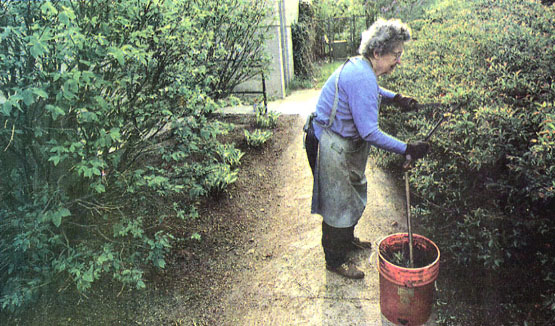HAMPTON: A CENTURY OF TOWN AND BEACH, 1888-1988
Chapter 23 — Part 9
Back to previous section — Forward to next section — Return to Table of Contents

[Hampton Union Photo by Jay Reiter.]
(Photo courtesy of Karen Ryan)
The Hampton Garden Club started on February 10, 1932, under the sponsorship of the Hampton Monday Club. Forty-nine men and women interested in gardening met at the home of Mr. and Mrs. Edward Seavey, Sr., at the corner of Mill and Winnacunnet roads. Mrs. Margaret Wingate presided until Channing Bean was elected president. Professors Jesse Hepler and James MacFarlane of the University of New Hampshire were guests. MacFarlane spoke on “Color Scheme in the Garden,” illustrated with many flowers from the university greenhouse. Then slldes were shown, and Mrs. Benoit sang two selections.
Fred R. Batchelder was president in 1933 and Kenneth Barnes in 1934. Other presidents were Marilla Brown, Margaret Wingate, Adeline Marston, Elisabeth Hammond, Ina Stevens, Bessie Hamilton, Lula O’Brien, Dorothy Smith, Virginia Wellington, Betty Cash, Ruth G. Stimson, Jean Sawyer, Ruth M. Nutter, Virginia Blake, Sue Ficke, Cora Munsey, Grace Hickley, Helen Hayden, Dorothy Bowen, Helen Garland, and Marilyn Marsh.
The club’s first big project was beautification of Five Corners, at the junction of Mace and Little River roads. The 1938 tercentenary was a stimulus. An article in the town warrant resulted in funds to make it a permanent park with suitable grading. The club gave a flagpole and a flag and planted many tulip bulbs there. For its work, the club received the Damon Cup from the State Federation of Garden park maintenance by the Town.
The next project was improvement at Depot Square, now Marelli Square. As a result, another warrant article was sponsored by the club and the area was improved with granite curbing, a crosswalk, a bubbler, and shrubbery. The club planted a memorial tree, an evergreen, in honor of the town’s veterans, and purchased a permanent marker.
In 1960, the club sponsored a warrant article to establish a Shade Tree Commission to coordinate all phases of town tree work. The commission has a long-range program for tree planting, removal, and professional protection.
The club sponsored an article to preserve the fish-house area as a part of the town’s park system. As a result of a petition by member Ruth G. Stimson, voters agreed with the idea of a seashore park and citizens gave $800 for granite posts and chain connections, and to identify the area as a park forevermore.
Ruth Stimson and the club made plans for landscaping the park. Many members worked very industriously to prepare the 440-foot long site. Their project was entered in a civic beautification contest sponsored by the State Federation and the Sears, Roebuck Foundation. Twice the club won $100 as seed money for use in landscaping first the north end and, in 1962, the south end. Pink and white berugosa roses were planted, along with bayberry bushes, beach peas, dusty miller, red cedars, red pines, autumn olives, sumac, and Harbox seashore goldenrod. The Boy Scouts erected a sign and the club planted geraniums and marigolds.
At another town meeting, citizens voted to name the area “RUTH G. STIMSON SEASHORE PARK” because of her efforts there. She received the President’s Bowl from the State Federation, and publicity in Sears’s national magazine, East Wind. Motel operators donated cement ends for settees, and the club bought five picnic tables for use in the park. It was listed in 1967 in the National Council of State Garden Clubs list of memorial gardens, as a seashore park.
Beginning in 1958, club members worked to arouse public opinion to conserve 350 acres or more of salt marsh for wildlife and conservation purposes. The club sponsored the warrant article that established the Hampton Marsh Conservation Committee, and three club members served on it until 1965, when the town voted to establish a Conservation Commission. Club members also were appointed to that body, and served for a decade.
In an effort to make Hampton more attractive, selectmen gave the club permission to plant anywhere on Town property. Window-boxes were maintained at the Interstate 95 toll booth, and at a traffic booth on Lafayette Road. Under the leadership of the Beautification Committee (Ruth M. Nutter, chair) and the Flower Arrangement Committee (Olga Armen, chair), the town office, library, and fire station also have been beautified seasonally. Plantings also were added to the town war memorials in Marelli Square.
Hampton Garden Club members have given priority to conservation activities to try to maintain the quality of the town’s environment. These civic interests have more enduring benefits for all citizens than some gardening projects of a more temporary nature.
— Ruth M. Nutter
See also this short letter to the editor of the Hampton Union detailing some of their history and their recent activities.